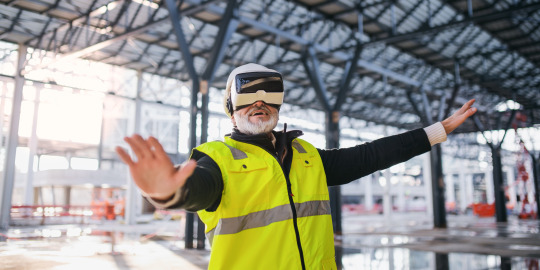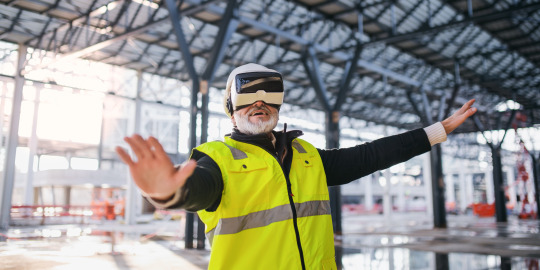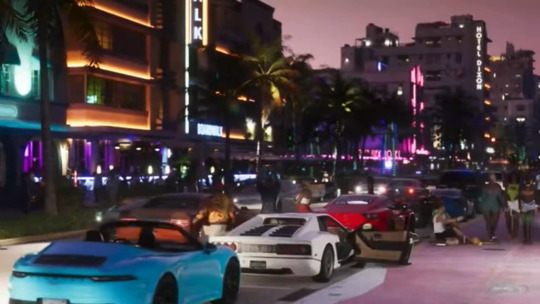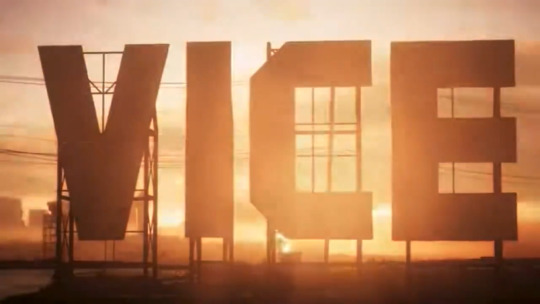#Virtual Reality Architecture development
Explore tagged Tumblr posts
Text
The Future is now exploring Virtual Showrooms in 2024

The Future of Design Virtual Showrooms in 2024 delves into pioneering Virtual Reality Architecture development. As VR designing companies lead this evolution, Phygital Solutions blends physical and digital realms seamlessly. These virtual showrooms redefine spatial experiences, offering immersive environments for interactive exploration and design visualization. Discover how architecture embraces the digital age, reshaping client engagements and design processes. However, if you don't have any idea about how to add your products or website to an iphygital, you can connect with our team at [email protected] or initiate a chat on our website, Futuresoft India.
0 notes
Text
As the metaverse continues to evolve, the demand for high-quality, engaging content has never been greater. This virtual universe is not just about immersive experiences; it’s also about the narratives, interactions, and creativity that bring those experiences to life. In India, one company stands out as a leader in this space: Simulanis Solutions. As a premier Metaverse Content Creation Company, Simulanis is dedicated to crafting compelling content that captivates users and enhances their journey through the metaverse.
#Metaverse Content Development#Metaverse Game Development#Virtual Reality Metaverse Content#Augmented Reality Metaverse Solutions#3D Metaverse Design#Immersive Metaverse Experiences#Metaverse App Development#Metaverse Animation Studio#Metaverse Platform Creation#Custom Metaverse Environments#Metaverse Virtual World Design#Metaverse Content Creation Agency#Metaverse Real Estate Development#Metaverse Architecture Services#Interactive Metaverse Solutions#Metaverse Digital Twins#Metaverse Experience Designers#NFT and Metaverse Content#Metaverse VR/AR Integration#Metaverse Integration Services
0 notes
Text
Building the Future with Virtual Reality in Architecture

Introduction
In the ever-evolving world of architecture and design, technology has played an instrumental role in reshaping the way professionals conceptualize and present their ideas. Among the many technological advancements, virtual reality (VR) has emerged as a transformative tool. ProtoTech Solutions, a pioneering company in the field of software development, has been at the forefront of harnessing VR technology to empower architects and designers. In this blog post, we will delve into the world of virtual reality software for architecture, with a particular focus on ProtoTech Solutions and their contributions to this exciting field.
The Rise of Virtual Reality in Architecture
Virtual reality is a computer-generated environment that can simulate physical presence in a real or imagined world, allowing users to interact with the surroundings. In the realm of architecture, VR has gained prominence for several reasons:
1. Enhanced Visualization: VR offers architects the ability to visualize their designs in three dimensions, providing a more immersive experience compared to traditional 2D drawings or even 3D models.
2. Improved Communication: VR enables architects to communicate their ideas more effectively to clients, contractors, and other stakeholders by allowing them to experience the design firsthand.
3. Efficient Design Iteration: With VR, architects can quickly iterate and make changes to their designs, reducing the time and cost associated with revisions.
4. Realistic Simulations: VR can simulate real-world conditions such as lighting, acoustics, and materials, helping architects make informed decisions during the design process.
Pioneering Virtual Reality for Architecture
ProtoTech Solutions is a leading 3D software development company specializing in engineering, 3D visualization, and virtual reality. Their innovative solutions have been instrumental in revolutionizing the architecture industry. Here are some of the key contributions of ProtoTech Solutions to the world of virtual reality for architecture:
1. VR Plugin Development: ProtoTech Solutions has developed powerful VR plugins that seamlessly integrate with popular architectural software like Autodesk Revit and SketchUp. These plugins allow architects to export their designs to VR environments effortlessly.
2. Realistic Environments: ProtoTech Solutions' VR software creates highly realistic environments, complete with accurate lighting, textures, and materials. This level of realism is crucial for architects to make informed design decisions.
3. Collaboration Tools: ProtoTech Solutions offers collaborative VR platforms where multiple stakeholders can meet in a virtual space to discuss and review architectural designs. This fosters better communication and streamlines the decision-making process.
4. Mobile VR Solutions: Recognizing the need for flexibility, ProtoTech Solutions has developed mobile VR solutions that work with devices like Oculus Quest, making it easier for architects to showcase their designs anywhere, anytime.
5. Training and Support: ProtoTech Solutions provides comprehensive training and support to architects and designers, ensuring they can leverage the full potential of VR technology in their projects.
Benefits of Using ProtoTech Solutions's VR Software
Architects and design professionals who choose ProtoTech Solutions' VR software can enjoy a wide range of benefits, including:
1. Enhanced Client Engagement: VR presentations are engaging and memorable, helping architects win clients' trust and approval more effectively.
2. Streamlined Design Processes: VR software by ProtoTech Solutions streamlines the design process, reducing the need for costly revisions and speeding up project timelines.
3. Better Decision-Making: Realistic VR simulations allow architects to make informed decisions about design elements, materials, and spatial arrangements.
4. Cost Savings: By catching design flaws early and reducing revisions, architects can save significant costs in construction and project management.
5. Competitive Edge: Architects and firms that embrace VR technology gain a competitive edge in the market, attracting clients who value innovative and immersive design experiences.
Conclusion
Virtual reality for architecture software, as exemplified by ProtoTech Solutions, has transformed the way architects and designers approach their projects. The power of VR lies in its ability to create immersive and realistic environments, facilitating better communication, decision-making, and design iteration. As technology continues to advance, it's clear that VR will play an increasingly vital role in the future of architecture. Architects and design professionals who harness the capabilities of VR software, like those provided by ProtoTech Solutions, are poised to excel in this dynamic and ever-evolving field.
#virtual reality software for architecture#ar vr app development#ar vr app development services#3d virtual reality software#vr app development services#virtual reality project management#virtual reality software architecture#augmented reality software architecture
0 notes
Text
Watching Carrie Bradshaw—erstwhile sex columnist, intrepid singleton, striver—float down the majestic staircase of her new Gramercy townhouse on a recent episode of And Just Like That while wearing a transparent tulle gown, on an errand to mail a letter, is one of the most cognitively dissonant television experiences I’ve had recently. And Just Like That has never been a particularly imaginative show with regard to women in midlife, but there’s still something fundamentally off about seeing one of the canonical female characters of our era transformed into a Gilded Age archetype, worrying about a garden renovation and choosing back-ordered fabric for a chaise. Carrie, suddenly, has many hats. She communicates with a lover via handwritten notes while she waits for his liberation from the home front in Virginia.
What’s happened to Carrie, truly, is money. Two decades after Sex and the City rolled to a televised close, acknowledging that its own cultural relevance was waning, its characters continue in zombified form on And Just Like That, pickled in a state of extreme privilege where nothing can touch them. The drama is lifeless, involving rehashed old storylines about beeping alarm systems and “a woman’s right to shoes” that serve mostly as a backdrop for clothes. Charlotte, in a questionable lace workout jacket, worries that her dog has been unfairly canceled. Miranda, in one of a series of patterned blouses, gets really into a Love Island–style reality show. (Remember Jules and Mimi?) Lisa wears feathers to a fundraiser for her husband’s political campaign. Seema, in lingerie, nearly burns her apartment down when she falls asleep with a lit cigarette, but in the end, all she loses is an inch or so of hair.
The point of the show is no longer what happens, because nothing does. The point is to set up a series of visual tableaus showcasing all the things money can buy, as though the show were an animated special issue of Vogue or Architectural Digest. What’s stranger still is that a series that once celebrated women in the workplace has succumbed to financial ideals right out of Edith Wharton: The women who earned their money themselves (Miranda and Seema) somehow don’t have enough of it (spoiler—they still seem to have a lot), while the ones who married money (Carrie, Charlotte, Lisa) breeze through life as an array of lunches, fundraisers, and glamping trips, with some creative work dotted into the mix for variety. The banal details of exorbitant wealth—well, it’s all quite boring.
Lately, most of television seems stuck in the same mode. Virtually everything I’ve watched recently has been some variation of rich people pottering around in “aspirational” compounds. On Sirens and The Better Sister, glossy scenes of sleek couture and property porn upstage the intrigue of the plot. On Mountainhead, tech billionaires tussle in a Utah mountain retreat featuring 21,000 square feet of customized bowling alleys and basketball courts. On Your Friends & Neighbors, a disgraced hedge-fund manager sneers at the vacuous wealth of his gated community (where houses cost seven to eight figures), but also goes to criminal lengths to maintain his own living standards rather than lower them by even a smidge. And on With Love, Meghan, the humble cooking show has gotten a Montecito-money glow-up.
“I miss TV without rich people,” the writer Emily J. Smith noted last month on Substack, observing that even supposedly normie shows such as Tina Fey’s marital comedy The Four Seasons and Erin Foster’s unconventional rom-com Nobody Wants This seem to be playing out in worlds where money is just not an issue for anyone. This is a new development: As Smith points out, sitcoms including Roseanne and Married … With Children have historically featured families with recognizable financial constraints, and the more recent dramedies of the 2010s were riddled with economic anxiety. Reality television, it’s worth noting, has been fixated on the lifestyles of the rich and bored virtually since its inception, but as its biggest stars have grown their own fortunes exponentially, the genre has mostly stopped documenting anything other than wealth, which it fetishizes via the gaudy enclaves and private jets of Selling Sunset and Bling Empire.
Serialized shows, too, no longer seem interested in considering the stakes and subtleties of most people’s lives. Television is preoccupied with literary adaptations about troubled rich white women, barbed satires about absurdly wealthy people on vacation, thrillers about billionaire enclaves at the end of the world. Even our contemporary workplace series (Severance, Shrinking) play out in fictional realms where people work not for the humble paychecks that sustain their lives, but to escape the grief that might otherwise consume them.
What does it mean that our predominant fictional landscapes are all so undeniably “elevated,” to use a word cribbed from the Duchess of Sussex? And Just Like That is evidence of how hard it is for shows that take wealth for granted to have narrative stakes, and how stultifying they become as a result. But we also lose something vital when we no longer see 99 percent of American lives reflected on the small screen. Money isn’t just making TV boring. It’s also reshaping our collective psyche—building a shared sense of wealth as the only marker of a significant life, and rich people as the only people worthy of our gaze. We’re not supposed to be able to empathize with the characters on-screen, these strutting zoo animals in $1,200 shoes and $30,000-a-night villas. But we’re not being encouraged to empathize with any other kinds of characters, either—to see the full humanity and complexity of so many average people whose lives feel ever more precarious in this moment, and ever more in need of our awareness.
On an episode in the final season of Sex and the City, a socialite named Lexi Featherston cracks a floor-to-ceiling window, lights a cigarette, and declares that New York is over, O-V-E-R. “When did everybody stop smoking?” she sneers. “When did everybody pair off?” As the hostess glares at her, she continues: “No one’s fun anymore. Whatever happened to fun? God, I’m so bored I could die.”
Famous last words: Lexi, of course, promptly trips on her stiletto, falls out the absurdly dangerous glass panel, and plummets to her death. Her arc—from exalted ’80s It Girl to coked-up aging party girl—was supposed to represent finality, the termination of the city’s relevance as a cultural nexus. “It’s the end of an era,” Carrie says at Lexi’s funeral, where Stanford is elated to have scored VIP seats next to Hugh Jackman. “The party’s officially over,” Samantha agrees. After six seasons of transforming how a generation of women dated, dressed, even drank, Sex and the City seemed to be acknowledging that its own moment had come to an end. The characters were undeniably older, no longer seeking anthropological meaning in a SoHo nightclub at 3 a.m. But the city that the show documented—and popular culture more broadly—had shifted, too: toward less spontaneity, less rebellion, and infinitely higher incomes.
The year that final season aired, 2004, is possibly when television’s prurient obsession with rich people really kicked off, with the launch of shows including Desperate Housewives, Entourage, and, notably, The Apprentice. A year earlier, Fox had premiered a soapy drama called The O.C., which charted the rags–to–Range Rover adventures of a teen from Chino who ended up ensconced in the affluent coastal town of Newport Beach. Until then, it had never occurred to me that teenagers could wear Chanel or drive SUVs that cost six figures, although watching them rattle around in McMansions the size of the Met provided much of The O.C.’s visual thrill. In direct response to the show’s success, MTV debuted the reality show Laguna Beach: The Real Orange County a year later, and in 2006, Bravo countered with its own voyeuristic peek into the lives of the rich and fabulous—The Real Housewives of Orange County.
Documenting wealth enticingly on television is a difficult balancing act: You want to stoke enough envy that people are inspired to buy things (gratifying advertisers along the way), but not so much that you risk alienating the viewer. Reality TV pulled it off by starting small. The women on the first season of Real Housewives were well off, but not unimaginably so. They lived in high-end family homes, not sprawling temples of megawealth. Similarly, when Keeping Up With the Kardashians debuted in 2007, the family lived in a generous but chintzy bungalow, having not yet generated the billions of dollars that would later pay for their minimalist compounds in Calabasas and Hidden Hills.
During the 2008 financial crisis, a critic for The New York Times wondered whether the tanking global economy might doom the prospects of shows such as The Real Housewives of Atlanta,which had just premiered, and turn them into “a time capsule of the Bling Decade.” But the fragility of viewers’ own finances, oddly, seemed to make them more eager to watch. Shows about money gratified both people’s escapist impulses and the desire to critique those who didn’t seem worthy of their blessings. As Jennifer O’Connell, a producer for The Real Housewives of New York City, put it to the Times a year later: “Everyone likes to judge.”
The toxic, unhappy, rich-people shows that have more recently proliferated on prestige TV—the Succession and White Lotus and Big Little Lies variation—cover their backs with cynicism. Money doesn’t make you happy, they assert over and over, even though studies suggest otherwise. The documentation of extreme wealth on television with such clarifying bitterness, they imply, surely inoculates audiences from pernicious aspiration. Except it doesn’t: The Four Seasons San Domenico Palace in Sicily was fully booked for a good six months following the second season of The White Lotus, despite the fictional bodies floating in the water. And a study conducted at the London School of Economics in 2018 found that a person’s increased exposure to shows that regularly “glamourize fame, luxury, and the accumulation of wealth” made them more inclined to support welfare cuts; it also noted other studies that found that the more people watched materialistic media, the more anxious and unhappy they were likely to be in their own lives.
Watching shows about wealth does, however, seem to stimulate the desire to shop, which is maybe why this latest season of And Just Like That feels intended for an audience watching with a second screen in their hand—all the better to harvest the aspirational consumption the show’s lifestyles might generate. Streaming services are already tapping into the reams of data they have on viewers by serving them customized ads related to the series they might be watching, and many are also experimenting with e-commerce. You could argue that And Just Like That is honoring the spirit of Sex and the City by putting fashion front and center. But the vacant dullness of the new season feels wholly of its time: This is television for the skin-deep influencer age, not the messy, pioneering drama it once was.
More crucially, Carrie and company take up space that deprives us of more shows like The Pitt, one of a sparse handful of series documenting the workers trying to patch up the holes in an ever more unequal America. No one seems to have anticipated that the Max series would be such a success. As workers today are being squeezed “for all their worth, no more chit-chatting at the water cooler, we’ve gotten to a point where reality for most people is quite unpleasant,” Smith writes on Substack. “And executives are betting that we don’t actually want to watch it.” The reality of the TV business also underscores why shows that sell us something—even if it’s just the illusion of exceptional prosperity as a default—are easier to commission. But audiences will always be drawn to drama, and the stakes of defiantly deglamorized series such as The Bear and Slow Horses feel necessary in this moment, when the state of the future relies so much on the direction and quality of our attention.
7 notes
·
View notes
Text
To follow up perhaps on the ideas of the previous exibit here: in nearly all man's historic religions human beings are presented as sparks in the great blazing holy light of God Almighty. Dogs don't go to heaven, cats and dolphins don't go to heaven according to most modern religions, but human beings who act righteously, who follow the word and laws of their chosen God will one day live in his kingdom for eternity. Humans alone of earthly living things have 'souls' and these souls exist beyond death. For the followers of Bhuddism one has the opportunity to escape the cycles of rebirth and join with the great white void of eternal enlightenment. Hindus see things in a similar vein. Muslims and Christians generally do not believe in reincarnation. Individuals have a single chance at life and likewise a single opportunity to escape eternal damnation if we fail to live "correctly". In Lovecraft's more complex fictional concepts of afterlife a specific and constantly delineated fate for those who die is uncertain. Some individuals live an afterlife in 'Dreamland'. In the story, THE STRANGE HIGH HOUSE IN THE MIST, protagonist Thomas Olney actually develops a secondary and more spiritually evolved personality while is earthly existence is still ongoing. Whether this luminous second self will exist after he dies as a physical entity is not definitely explained. The idea of reaching a higher plane of existence is explored by HPL in a number of stories. Yet, lovecraft never let himself become tied to any particular view of afterlife. Though HPL claimed to have been an atheist or at least an agnostic by the age of 8, his fiction likely served him to some degree as a testing platform to intellectually judge the strength of the wall of rock- solid rationality, logic, and reason, that he used to develop his view of reality in the universe. Horrible as death might be for some in Lovecraft's fiction at least there is 'something' there for some who face death. In his personal view of life we are only here once and briefly. There is no life after death, no eternal soul, no God waiting for us and no heaven to aspire to. Sex, money, power, really didn't mean much to H. P. Lovecraft. He had some loyal friends, loved visiting museums and libraries, found pleasure in reading, seeking out beauty in art, gardens, literature, and architecture. He loved cats as a species almost to a point of worship and felt a great personal connection to his hometown of Providence RI as well. For all his negatives, his occasional disquieting outbursts, Lovecraft was a genuine and gentlemanly individual who never wronged others or worked to harm others in any practical sense. H. P. Lovecraft was not on any level a conniving or devious individual. In many ways he remained childlike all his life. The negatives he proclaimed about other people as a group were born from his extreme bookishness, and not particularly from practical experience. He proclaimed some pretty obnoxious things at time in essays and letters, but as he grew older and delt with persons of non-Anglo backgrounds in person his attitudes softened considerably. The man who virtually worshipped continuity continued to evolve, and mature until the end. He lived a quiet and unassuming life finding joy in small things, but ultimately disappointed by what he saw as a bland and hopeless reality. For HPL we live on this little planet, toiling, learning, dreaming, and reaching out pathetically grasping for meaning and finding NOTHING. (Exhibit 550)






10 notes
·
View notes
Text
Architectural Visualization Company
3D Power is a leading 3D Architectural Walkthrough Animation Service Provider in Secunderabad. We are a team of 3D Walkthrough Experts and we provide high-quality 3D renders for your projects. 3D Power is a pioneer in the field of 3D Rendering, we provide 3D Walkthroughs, 3D Virtual Reality experiences, and Real Estate Branding.
With 24 years of rendering experience At 3D Power, we are proud to be known as the foremost 3D Walkthrough Animation & 3D Architectural Rendering firm. We provide photorealistic 3D walkthrough services for Townships, Highrises, Apartments, Smart Cities, Hospitals & Schools etc. Our innovative solutions have captured the attention of architects, real estate developers across the world.
Our Services
3D Architectural Visualization Services In Secunderabad
3D Walkthrough Animation Services In Secunderabad
3D VR Walkthrough Services In Secunderabad
Media & Branding For Real Estate
61, New RH Colony, Amarpreet Square, Chhatrapati Sambhaji Nagar (Aurangabad), Maharashtra 431001
91 9372032805
Facebook : https://www.facebook.com/threedpower
Youtube : https://www.youtube.com/@3dpowerwalkthrough
Instagram : https://www.instagram.com/3dpower/
Pinterest : https://in.pinterest.com/3dpower/
LinkedIn : https://www.linkedin.com/in/3dpower/
Working hours : Mon - Sat 10:00 AM To 07:00 PM
















3 notes
·
View notes
Text

In today’s fast-paced digital landscape, the demand for captivating and immersive content is at an all-time high. Whether you're an advertising agency, a game developer, or a brand looking to tell your story with impact, high-quality animation can be the key to unlocking audience engagement. That’s where 3D Animation Company Virtual Element Studios steps in, offering innovative solutions tailored to bring your vision to life.
Why 3D Animation Matters
As technology evolves, traditional 2D visuals are no longer enough to stand out in the crowded marketplace. Businesses are increasingly turning to three-dimensional animation to elevate their messaging and enhance user experience. From product visualization and architectural walkthroughs to gaming and cinematic sequences, 3D animation offers a unique blend of realism, creativity, and functionality.
At its core, 3D animation bridges the gap between imagination and reality. It allows you to visualize concepts that are difficult—or even impossible—to capture with live-action video. For industries like healthcare, manufacturing, and real estate, 3D renders provide not only aesthetic appeal but also clarity and precision that improve communication and decision-making.
Meet the Experts in Visual Innovation
Virtual Element Studios is a premier 3D Animation Studio that specializes in transforming creative ideas into compelling animated content. With a team of experienced artists, animators, and storytellers, the studio blends technical expertise with artistic flair to deliver stunning visual experiences across multiple platforms.
What sets Virtual Element Studios apart is its collaborative approach. The studio works closely with clients to understand their brand, audience, and objectives. This ensures that every project—whether a short explainer video or a full-length animated film—is perfectly aligned with your goals and vision.
The studio’s portfolio spans a wide array of industries, showcasing its ability to adapt and innovate regardless of the project's complexity. Whether it’s animating intricate machinery or creating fantastical environments, their work consistently exceeds client expectations.
Comprehensive Solutions That Deliver Results
Virtual Element Studios offers a complete suite of 3D Animation Services designed to support your business at every stage of production. From initial concept design and storyboarding to modeling, texturing, rigging, and final animation, their team manages the entire process with precision and creativity.
Their services are ideal for:
Product Visualization: Showcase your product in action before it’s even built.
Architectural Animation: Bring blueprints and layouts to life for stakeholders.
Medical & Technical Animation: Explain complex procedures or mechanisms with clarity.
Marketing & Advertising: Create scroll-stopping content for social media and digital campaigns.
Entertainment & Gaming: Build immersive worlds and lifelike characters.
By combining cutting-edge technology with a passion for storytelling, the studio ensures that every frame delivers value, engagement, and a lasting impression.
Why Choose Virtual Element Studios?
In an industry that thrives on innovation, Virtual Element Studios remains at the forefront by continually pushing creative boundaries. Their commitment to quality, timely delivery, and customer satisfaction makes them the go-to partner for businesses seeking impactful visual content.
Moreover, the studio understands the importance of staying ahead in SEO and digital marketing. Their animations are optimized for online use, making them not only visually appealing but also effective in driving traffic and conversions.
Final Thoughts
If you're looking to elevate your brand with dynamic and engaging visuals, partnering with a top-tier animation studio is essential. Virtual Element Studios combines artistic excellence with technical expertise to deliver animations that captivate, inform, and inspire.
Visit Virtual Element Studios today and discover how their innovative 3D animation solutions can bring your ideas to life with stunning clarity and emotion.
4 notes
·
View notes
Text
UK Prime Minister Keir Starmer hosted a virtual meeting of Western leaders on March 15 to discuss rapidly developing plans for a “coalition of the willing” to oversee the implementation of a possible peace deal between Russia and Ukraine. The event was the latest in a series initiated by Starmer as he looks to provide Ukraine with long-term security and reduce the threat of a renewed Russian invasion.
Earlier in March, the British PM and his team also reportedly worked extensively behind the scenes to repair the damage following Ukrainian President Volodymyr Zelenskyy’s disastrous Oval Office meeting with US President Donald Trump and Vice-President JD Vance. These efforts helped prepare the ground for a US ceasefire proposal that was subsequently accepted by Ukraine in Saudi Arabia.
Starmer’s recent contributions underline Britain’s longstanding commitment to Ukraine. Since the eve of Russia’s full-scale invasion more than three years ago, the UK has consistently been at the forefront of efforts to boost Ukrainian resilience and oppose Russian aggression. With the future of US assistance to Ukraine now in question amid the Trump administration’s pivot away from Europe, Britain is taking the lead as the continent adapts to new security realities and seeks to prevent a Russian victory in Ukraine.
Since the onset of Russia’s invasion in early 2022, the UK has been among Ukraine’s biggest backers. According to data from the Kiel Institute for the World Economy, British military aid up to the end of 2024 totaled $10.4 billion, putting the country in third place behind the United States and Germany among Ukraine’s international partners. Crucially, the UK has also often led by example in providing Ukraine with new categories of weapons including modern battle tanks and cruise missiles, paving the way for others to do likewise.
In addition to direct military aid, British support for Ukraine also extends to cooperation in areas including cybersecurity, intelligence, and countering hybrid threats. The UK continues to assist in the reform of the Ukrainian defense sector and provides training for Ukrainian military personnel. In the diplomatic arena, Britain advocates for tough sanctions measures against Russia and draws international attention to the Kremlin’s crimes in Ukraine.
This strategic support for Ukraine has enabled Britain to reassert its leadership position on the global stage following the country’s exit from the European Union. By supporting Ukraine, post-Brexit Britain has demonstrated that it remains a force in international affairs and a major contributor to European security. British support for the Ukrainian war effort has also made it possible to overcome Brexit-related tensions and build new partnerships with key European countries such as Germany, France, and Italy.
British backing for Ukraine is about much more than mere power projection, of course. There is a broad cross-party consensus in Westminster that Europe’s collective security is inextricably linked to the outcome of the war in Ukraine. The full-scale Russian invasion of Ukraine has coincided with a particularly turbulent period in British politics, with four different prime ministers and a change in government since February 2022. Throughout all this, the country’s position on Ukraine has remained largely unchanged.
Ties between London and Kyiv are now poised to strengthen further. The exact nature and objectives of a potential international peacekeeping force for Ukraine are not yet clear, but if current plans proceed as anticipated, it seems all but certain that British troops will feature prominently in any deployment. This would deepen a bilateral relationship that looks set to be at the heart of Europe’s new security architecture in the coming years.
As Europe adjusts to the dramatic shifts in US foreign policy initiated by the Trump administration, Britain is playing an important role as a transatlantic intermediary, while also leading European efforts to bolster Ukraine’s defense against Russian aggression. Almost ten years after the country voted to leave the EU, Britain is now once again proving itself indispensable to European security.
6 notes
·
View notes
Text
What Future Trends in Software Engineering Can Be Shaped by C++
The direction of innovation and advancement in the broad field of software engineering is greatly impacted by programming languages. C++ is a well-known programming language that is very efficient, versatile, and has excellent performance. In terms of the future, C++ will have a significant influence on software engineering, setting trends and encouraging innovation in a variety of fields.
In this blog, we'll look at three key areas where the shift to a dynamic future could be led by C++ developers.
1. High-Performance Computing (HPC) & Parallel Processing
Driving Scalability with Multithreading
Within high-performance computing (HPC), where managing large datasets and executing intricate algorithms in real time are critical tasks, C++ is still an essential tool. The fact that C++ supports multithreading and parallelism is becoming more and more important as parallel processing-oriented designs, like multicore CPUs and GPUs, become more commonplace.
Multithreading with C++
At the core of C++ lies robust support for multithreading, empowering developers to harness the full potential of modern hardware architectures. C++ developers adept in crafting multithreaded applications can architect scalable systems capable of efficiently tackling computationally intensive tasks.

C++ Empowering HPC Solutions
Developers may redefine efficiency and performance benchmarks in a variety of disciplines, from AI inference to financial modeling, by forging HPC solutions with C++ as their toolkit. Through the exploitation of C++'s low-level control and optimization tools, engineers are able to optimize hardware consumption and algorithmic efficiency while pushing the limits of processing capacity.
2. Embedded Systems & IoT
Real-Time Responsiveness Enabled
An ability to evaluate data and perform operations with low latency is required due to the widespread use of embedded systems, particularly in the quickly developing Internet of Things (IoT). With its special combination of system-level control, portability, and performance, C++ becomes the language of choice.
C++ for Embedded Development
C++ is well known for its near-to-hardware capabilities and effective memory management, which enable developers to create firmware and software that meet the demanding requirements of environments with limited resources and real-time responsiveness. C++ guarantees efficiency and dependability at all levels, whether powering autonomous cars or smart devices.
Securing IoT with C++
In the intricate web of IoT ecosystems, security is paramount. C++ emerges as a robust option, boasting strong type checking and emphasis on memory protection. By leveraging C++'s features, developers can fortify IoT devices against potential vulnerabilities, ensuring the integrity and safety of connected systems.
3. Gaming & VR Development
Pushing Immersive Experience Boundaries
In the dynamic domains of game development and virtual reality (VR), where performance and realism reign supreme, C++ remains the cornerstone. With its unparalleled speed and efficiency, C++ empowers developers to craft immersive worlds and captivating experiences that redefine the boundaries of reality.
Redefining VR Realities with C++
When it comes to virtual reality, where user immersion is crucial, C++ is essential for producing smooth experiences that take users to other worlds. The effectiveness of C++ is crucial for preserving high frame rates and preventing motion sickness, guaranteeing users a fluid and engaging VR experience across a range of applications.

C++ in Gaming Engines
C++ is used by top game engines like Unreal Engine and Unity because of its speed and versatility, which lets programmers build visually amazing graphics and seamless gameplay. Game developers can achieve previously unattainable levels of inventiveness and produce gaming experiences that are unmatched by utilizing C++'s capabilities.
Conclusion
In conclusion, there is no denying C++'s ongoing significance as we go forward in the field of software engineering. C++ is the trend-setter and innovator in a variety of fields, including embedded devices, game development, and high-performance computing. C++ engineers emerge as the vanguards of technological growth, creating a world where possibilities are endless and invention has no boundaries because of its unmatched combination of performance, versatility, and control.
FAQs about Future Trends in Software Engineering Shaped by C++
How does C++ contribute to future trends in software engineering?
C++ remains foundational in software development, influencing trends like high-performance computing, game development, and system programming due to its efficiency and versatility.
Is C++ still relevant in modern software engineering practices?
Absolutely! C++ continues to be a cornerstone language, powering critical systems, frameworks, and applications across various industries, ensuring robustness and performance.
What advancements can we expect in C++ to shape future software engineering trends?
Future C++ developments may focus on enhancing parallel computing capabilities, improving interoperability with other languages, and optimizing for emerging hardware architectures, paving the way for cutting-edge software innovations.
10 notes
·
View notes
Text

Environmentally-friendly InSb/InP colloidal quantum dots for fast and sensitive short-wave infrared photodetectors
Applications such as LIDAR, 3D imaging for mobile devices, automotive and augmented/virtual reality or night vision for surveillance, rely on the development of short-wave infrared (SWIR) photodetectors. These devices are capable of seeing in the region of the spectrum that is invisible to our eye since they operate in the spectral window of 1-2 µm. The SWIR light sensor industry has been dominated for years by epitaxial technology, mainly based on devices made of indium gallium arsenide (InGaAs). However, several factors such as high production costs, low-scale manufacturability and incompatibility with CMOS have confined the epitaxial technology to niche and military markets. In contrast, the potential of SWIR photodetectors made of colloidal quantum dots (CQDs), nanoscale semiconductor materials, has attracted significant interest in recent years due to their appealing features, such as low cost and compatibility with CMOS architecture, among others.
Read more.
8 notes
·
View notes
Text
In this blog, we delve into the growing Metaverse industry in India and showcase Simulanis, a leading Metaverse development company in the country. As Metaverse startups in India continue to rise, we explore the innovative solutions, technologies, and Metaverse app development services offered by Simulanis, positioning it as one of the best Metaverse companies in India
#metaverse company in india#metaverse development company#simulanissolutions#Metaverse Solutions#Metaverse Development Services#Virtual World Development#3D Metaverse Creation#Metaverse Platform Development#Blockchain Metaverse#Custom Metaverse Design#Metaverse App Development#Virtual Reality Metaverse#NFT Integration in Metaverse#Metaverse Architecture#Metaverse Software Solutions#Metaverse Gaming Development#Metaverse for Business#Decentralized Metaverse#Cross-Platform Metaverse#Metaverse Real Estate Development#Augmented Reality Metaverse#Metaverse Ecosystem#Metaverse Experience Design
0 notes
Text
DOUG AITKEN: virtual synthesisers (ACTOR'S HELL)

what is the universe made of and why?
childlike wonder of God himself:
YOU GUESS THE BOOK I REFERENCED THIS FROM: ASK ME FOR HELP OR YOU'RE DEAD
now answered:
AUTISM IN CHILDHOOD: the way children prosper is their natural shyness to living (they act like they're married but older when younger), so what actually happens is that children act like the judge all the time, like that is their personality which is how they cannot make eye contact that easily or straining from emotional boundaries through physical contact and times come again for a very acute way of understanding the world makes them limited to speech by hatred that of whosoever in the past in the emotional boundary (their ancestry by family is separate from their family's physical bloodline and it is esteemed that time itself makes their blood relative be of a successor to a lifetime body of that social deficit reason making them being who they are now (bloodline believed) and with who they become amongst social spontaneity that gives them those little quirks that actually resemble them of behaviours to of reasonable change (they live by expression) and subtleties in emotional heatwaves (ambience of the time makes them living beyond their years hyper-emotionally,) so you're looking at a kid who is born from a year ahead of your time forwards than backwards, hence their emotional development is not even found in statistics showing what brain sensitivities are which is why ASD in children from 1982 onwards have an emotional bearing heatwave that breaks them from social intrepidation (everybody being aware of you listening to yourself by your ability to believe makes you superficial enough to be a 'mind' but you're not even allowed to talk about social functionings the way you used to see, so you're able to believe in a hyper-normal universe that acquaints to your taste (TV theory) and you have a company that suits your lifelong imitation of knowledge imitating man) = that to a kid is much more bearing than being a stereotype does not exist (abliesm) so it is your family that makes you see through your likeness to wonder than what you wear in actual reality that has a bigger grip on personal identity capturing you on the childs upbringing later on
IMAGINATION IN A CHILD = autism does not define a man at all if that is personally attacked and attached onto a child growing up of maturity to it's mother become father, however 'theory' is a father's wonder to reject his blood for bodily fluids attained to keep his dream going, naturally only women now have autism due to emotional sensitivity of the latter, never men. so what that is, is that 'theory' is escapism to a man to embrace architectural socialism in his works (usually chef's look for a baby cartoon disaster bastard parable to the giving nature of the architect become married child now) so, the world gives more influence of the child's life being and she is to a boy's given ability to break himself down for her by intuition (intuition is meant for men than imagination meant for women). all women are now blind unless believed, so there is no remote status to her in and out of social norms of being a liar if she is (men know best) and sincerely upon act, a child's life is worth the risk to be inspired now than she is to be of use in adult films delaying apes (stupid people). the way the emotional lack of hibernation is that ways of now using the remote (heart) is that of the essence that to a good man turned into a devil now has the dream to upgrade sanity to normality for the world of wonder to continue on (since the repairable abject is not even there to commit at last), he is of the world's weight that is not even allowed to see or feel that he is not even going to try (daughter parable is instilled in men in every single way that he is able to be judged and condemned while women walk the earth for free, men get the damnation mark, never women)
DISABILITY ALLOWANCE CONTROL = functional ways of living is that of control through reasonable eye (maturity in energy in greek is able to restore organs failing of, so what that is, is that you're able to control the universe by theory and not heartbreak), there is no intelligence remark that kills a man to forgive and believe when kindness of that is overcedes everything you knew in the past (like meets like) but in general actuality, you're looking at the universe as if it's already done (Dr. Joe Dispenza's remote control in the works by forgotten priniciples of childhood is hated to), and there be the word disabled is now a community in the dead winds (Hollywood undead), there is no such thing as kindness control. forgotten municipals of human-remote is thoughts of world-like reasons to continue is humour, solely humour makes sense to them to theory to progress the forgotten means to emotional set-backs that changes the directory of the mind with our without personal boundaries set by time-change chances (thalidomide babies) to contribution to childhood development that controls the homo-sapien agenda to now (invented) Lena-biosis genome to travel on forwards to reasonable thought outside of mind-awareness to cybernetic (ref: Doctor Who) energies collected from the earth that stimulates awareness online (product of innovation (root of belief stimulated forward: Islam), so there is always going to be a difficulty being experimented on challenges on the human persona that continues on to alien experience (technically alien than human whereas non-neuro-divergents are human) are remotely aware from the reason where they collect their power from (human sunflowers)
ACUTE AWARENESS = the brain is not actually there. you don't want to think but alike the kid is actually alike the 'parent of fame instilled progression' so the parent (woman = physically disabled child and man = first born daughter with ASD) so the body is not present with the child anymore (alike the parent) so the child is a body of thought (alien) so the parent makes the child live a human experience, and that the brain is the fault of world created right now through motion-change of influence (wealth takes over influence than heart which has a binary influence of the 'end-times' effect, which often-so is confusing with the polarity of the stars (Polaris + Vega) shifting axis that was once thought (year 2024) that was how the world ended but in theism.
ATTENTION DEFICIT DISORDER = esteeming interest is how the brain develops a fatal attraction to change (brain is existent to the challenging wealth of occuppance of 'another earth') so that theory stays with you entirely to compete otherwise (alternate dimensions discovered on TV situationships all the time) so it's natural to believe in the 'why's' of everything to lead the answer to the worst case scenario (now you know HSJ), and creation of the worst case scenario is how TV competition stimulates the rise of children competing for a natural solution (parents belief of humanity is how genetics matters to aliens) so you're now the enemy in all natural reality to keep 'the demon' hidden from fact-to-thought immunity (loneliness), so you debate the 'devil' and it is you and always your morals don't strain the same idea to 'acting upon it' and likely so your grandparents change your ideas all the time since parental interest becomes you by 'infatuation of the' and it's your entire life (hyperactive interest of the mediocre), and so you make changes regardless as a matter to teach since sarcasm is an inspired opportunity elsewhere (point of abbreviation to the lost-father's best friend = companion now father-like figure (inspiration) and there you go, the world is not the same because you're the TV reason of view (so you know HSJ by a generational POV, so you knew the father figure-metaphor now physical (he says 'hi') that's just the world being taught back to the child listening to the bean in her eye (left pupil: father) and they share a common duality met with the 'ocean mother' (reason of change is death of the case of view: father is only the reason to become a murderer if the child possesses now PTSD -
2 notes
·
View notes
Text
The Ultimate Guide to Virtual Reality Software for Architecture

In the ever-evolving world of architecture, staying at the forefront of technology is paramount. One such technological advancement that has revolutionized the architectural industry is virtual reality (VR). Virtual reality architecture software has ushered in a new era of design, presentation, and client engagement. In this comprehensive guide, we'll explore the world of virtual reality architecture software, its benefits, and a spotlight on ProtoTech Solutions as a leading player in the field.
Understanding Virtual Reality Architecture Software
Virtual Reality (VR) is a technology that immerses users in a computer-generated environment, allowing them to interact with and navigate through it as if it were real. In architecture, VR software leverages this technology to create immersive 3D environments of architectural designs and spaces.
Key Features of Virtual Reality Architecture Software
1. Immersive Visualization: VR software provides architects, designers, and clients the ability to walk through a building or space as if they were physically present. This immersive experience enhances design comprehension.
2. Real-time Collaboration: Many VR architecture tools offer real-time collaboration features, allowing multiple stakeholders to review and make decisions on designs simultaneously, no matter where they are located.
3. Design Iteration: VR software enables architects to make real-time changes to designs, which can be immediately visualized, facilitating rapid design iteration and decision-making.
4. Client Engagement: Using VR during client presentations is a powerful way to convey design concepts, helping clients understand and feel the space before it's built.
5. Data Integration: Some VR solutions integrate with Building Information Modeling (BIM) software, enabling architects to import 3D models and data for a seamless design-to-VR workflow.
Benefits of Using Virtual Reality Architecture Software
1. Enhanced Design Communication
VR software bridges the gap between architectural drawings and the client's understanding of the design. Clients can "walk" through the virtual space, gaining a comprehensive understanding of the project, reducing miscommunication, and enhancing the decision-making process.
2. Streamlined Design Review
Design teams and clients can collaborate in real-time within the virtual environment, making changes and annotations directly in the 3D model. This streamlines the design review process and ensures everyone is on the same page.
3. Reduced Costs
By identifying design flaws and issues early in the process, VR architecture software can help avoid costly revisions during construction. It also allows for better design optimization, potentially reducing construction costs.
4. Competitive Advantage
Architectural firms that adopt VR technology gain a competitive edge by showcasing their projects in immersive, engaging ways. It can impress clients and help secure new projects.
Spotlight on ProtoTech Solutions
ProtoTech Solutions is a renowned name in the world of virtual reality architecture software. As a leader in this field, ProtoTech Solutions offers a range of innovative solutions tailored to the needs of architects and designers.
ProtoTech's Virtual Reality Software Features
1. Immersive VR Experiences: ProtoTech's VR solutions provide highly immersive experiences, making it easy for clients and stakeholders to visualize architectural designs.
2. Cross-Platform Compatibility: ProtoTech offers VR solutions that work seamlessly across multiple platforms and devices, including VR headsets, desktops, and mobile devices.
3. BIM Integration: ProtoTech's VR software can integrate with popular BIM tools, enabling architects to import complex 3D models and data effortlessly.
4. Real-time Collaboration: ProtoTech's collaboration features allow architects and clients to review and modify designs in real-time, improving communication and decision-making.
Why Choose ProtoTech Solutions?
Expertise: ProtoTech Solutions has a team of skilled professionals with extensive experience in VR development and architecture.
Customization: They offer tailored solutions to match the unique needs of architectural firms and construction companies.
Proven Track Record: ProtoTech has a strong track record of delivering high-quality VR solutions for the architecture industry.
Support and Training: ProtoTech provides comprehensive support and training to ensure users can maximize the benefits of their VR software.
In conclusion,
virtual reality architecture software has redefined the way architects design, collaborate, and present their projects. With ProtoTech Solutions at the forefront of this technological revolution, architects and designers have a trusted partner to help them unlock the full potential of VR in their work. Embrace the power of virtual reality and stay ahead in the world of architecture.
#virtual reality software for architecture#ar vr app development#ar vr app development services#ar vr development services#3d virtual reality software#virtual reality app development#virtual reality applications development#vr app development services#vr software for architecture#virtual reality project management#virtual reality software architecture#vr application services#augmented reality software architecture#virtual reality architecture software#augmented reality android development
0 notes
Text
Nintendo Opens Its First Ever Museum

Gaming enthusiasts, tech historians, and Nintendo fans, rejoice! Nintendo has just opened its first-ever museum, and it's a treasure trove for anyone passionate about the evolution of video games. Located in Uji near Kyoto, the museum offers a captivating look at one of the world's most iconic gaming companies. This article will guide you through the highlights and invaluable experiences awaiting visitors.
Evolution of Nintendo
A Timeline of Innovation
At the heart of the museum is a unique timeline exhibit showcasing the evolution of Nintendo's gaming consoles and handheld devices from the early 1980s to the present. This section is a vivid walk down memory lane, featuring everything from the original Nintendo Entertainment System (NES) to the latest Nintendo Switch. Each console and device is displayed with detailed information about its development, impact, and cultural significance.
Preserving History
The museum serves as a guardian of gaming history, preserving not only the physical consoles but also the stories and milestones that have made Nintendo a household name. From its humble beginnings as a maker of 'hanafuda' playing cards in 1889 to its current status as a global gaming titan, Nintendo's rich history is meticulously chronicled.
Interactive Experiences
Hands-On Gaming
One of the museum's most thrilling aspects is its range of interactive experiences. Visitors can play rare and unreleased games, providing a unique opportunity to explore titles that never made it to market. Additionally, virtual reality demonstrations offer a glimpse into the future of gaming technology.
Live Events
The museum also hosts live events featuring game developers and industry experts. These events provide valuable insights into the game development process and offer visitors a chance to engage directly with the creators of their favorite games.
Celebrating Nintendo's Characters
Iconic Characters
A dedicated section of the museum celebrates the history of Nintendo's iconic characters, from Mario and Luigi to Link and Zelda. Original artwork, concept designs, and behind-the-scenes footage offer an intimate look at the creative process behind these beloved figures.
Creative Process
Visitors can see how these characters evolved from initial sketches to fully realized icons, gaining a deeper appreciation for the artistry and innovation that define Nintendo's games.
Cultural Impact and Community
Shaping the Industry
Nintendo has played a crucial role in shaping the global gaming industry. The museum highlights this impact, showcasing how the company has influenced gaming culture, technology, and community-building.
Fostering Community
Nintendo's commitment to fostering a sense of community among fans is evident throughout the museum. Interactive displays and communal gaming areas encourage visitors to share their experiences and connect with fellow enthusiasts.
Rotating Exhibits and Special Appearances
Ever-Changing Exhibits
To keep the museum experience fresh and engaging, special rotating exhibits feature different themes and rare items. Whether it's an exhibit on the evolution of handheld gaming or a showcase of early prototypes, there's always something new to discover.
Guest Appearances
The museum also plans to host guest appearances by game developers, artists, and other industry luminaries. These special events offer visitors unique opportunities to learn from the experts and gain deeper insights into the world of gaming.
Visitor Experience
Layout and Design
The museum's layout is designed to offer a seamless and immersive experience. Key areas include the Evolution of Nintendo, Interactive Experiences, Character Celebrations, Cultural Impact, and Rotating Exhibits. A central hub serves as the starting point, providing an overview of the day's events and exhibits.
Unique Architectural Features
The museum's modern design incorporates elements from classic Nintendo games and consoles. Oversized replicas of famous game items and characters add a playful touch, while interactive elements like touchscreens and play areas engage visitors of all ages.
Accessibility and Comfort
The museum is fully accessible, with wide pathways, elevators, and rest areas. Information is available in multiple languages, and staff are on hand to assist with any needs. Clear signage guides visitors through the exhibits, ensuring a logical and enjoyable flow.
Frequently Asked Questions
What are the museum's opening hours?
The Nintendo Museum is open from 10:00 AM to 6:00 PM, Tuesday through Sunday. Please note that the museum is closed on Mondays, except when Monday falls on a national holiday, in which case it remains open and closes the following day instead.
How can I purchase tickets?
Tickets can be purchased online through the official Nintendo Museum website or at the ticket counter on-site. It is recommended to book tickets in advance to ensure availability, especially during peak times and special events.
Is there a guided tour available?
Yes, guided tours are available for groups and individuals. These tours provide an in-depth look at the exhibits and a comprehensive overview of Nintendo's history. Booking in advance is recommended to secure a spot.
Are there any age restrictions?
The museum is designed for visitors of all ages. However, children under the age of 16 must be accompanied by an adult. Certain interactive experiences may have age or height restrictions for safety reasons.
Is there a gift shop at the museum?
Yes, the Nintendo Museum features a gift shop offering a wide range of exclusive merchandise, including collectibles, clothing, and memorabilia inspired by Nintendo's games and characters.
Can I bring food and beverages into the museum?
Outside food and beverages are not allowed inside the museum. However, there is a café on-site offering a variety of snacks, meals, and beverages for visitors to enjoy.
Are there any COVID-19 safety measures in place?
The museum follows all local COVID-19 safety protocols, including mandatory mask policies, regular sanitization of facilities, and capacity limits. Visitors are encouraged to check the museum's website for the latest updates on safety measures before visiting.
Conclusion
The Nintendo Museum is a monumental addition to the world of gaming and technology. It offers a comprehensive and engaging look at Nintendo's storied history, its innovative contributions to the gaming industry, and its enduring cultural impact. Whether you're a longtime fan or new to the world of Nintendo, the museum promises an experience that's both educational and entertaining.
Don't miss this opportunity to explore the magic of Nintendo. Plan your visit today and be part of a community that celebrates creativity, innovation, and the joy of gaming.
Location:
Nintendo Museum
56 Kaguraden, Ogura-cho, Uji-shi, Kyoto 611-0042
5-minute walk from the East exit of Ogura Station (Kintetsu Railway Kyoto Line)
8-minute walk from the North exit of JR Ogura Station (JR Nara Line)
Hours of Operation:
10:00-18:00 (Last admission 16:30)
Closed on Tuesdays and during the New Year's holiday season (Dec. 30 – Jan. 3)
Please take public transportation to reach the museum.
Nintendo Official Website
Mark your calendars for the grand opening on October 2, 2024, and get ready to embark on a nostalgic and inspiring journey through the world of Nintendo.
Credit: Proelectech
#soundquality#gamingsetup#homeaudio#actioncamera#logitech#musiclovers#audiophile#homeentertainment#audioquality#audioexperience#nintendo museum#nintendo
2 notes
·
View notes
Text







Grand Theft Auto Coming to Miami Beach: GTAVI
Miami Beach, famously known as Vice City in the Grand Theft Auto video game franchise, is about to come to life like never before. As Miami Beach Notary 305, we are excited to share that the highly anticipated trailer for the upcoming installment, Grand Theft Auto VI, has just been released a day early, and the visuals are nothing short of astonishing. In this blog post, we will explore how the game's attention to detail has made Miami Beach look and feel like a living simulation, creating an immersive experience for both gamers and Miami residents alike.
As Miami Beach Notary 305, we are proud to see that the developers of Grand Theft Auto VI have gone above and beyond to recreate the essence of Miami Beach in the game. From the breathtaking beaches and iconic art deco architecture to the vibrant nightlife and bustling streets, every aspect of the city has been meticulously reproduced. As you watch the trailer, you'll be amazed at how the virtual Miami Beach mirrors its real-life counterpart, making it hard to distinguish between the two.
The release of the GTAVI trailer couldn't have come at a better time - Art Basel week in Miami Beach. This annual event celebrates the convergence of art, culture, and creativity, drawing artists and enthusiasts from all around the world. As Miami Beach Notary 305, we are eager to see if there will be a unique art display that incorporates Grand Theft Auto VI as a form of advertising during this vibrant week. The fusion of virtual and real art would be an exciting prospect to witness.
As Miami Beach Notary 305, we invite you to join us in the coming weeks as we share pictures and developments leading up to the release of Grand Theft Auto VI in 2025. One fascinating aspect will be comparing the real-life architecture and buildings in our Miami Beach neighborhood to their virtual counterparts in the game. This comparison will highlight the level of detail and accuracy achieved by the game developers, showcasing how the virtual world of GTAVI closely emulates the real Miami Beach experience.
At Miami Beach Notary 305, we are thrilled about Grand Theft Auto VI's early release of the trailer, which has captivated both video game enthusiasts and Miami residents. The lifelike representation of Miami Beach in the game has generated excitement and anticipation for the upcoming release. As we delve deeper into the virtual world of GTAVI, we, as Miami Beach Notary 305, will explore the similarities and differences between the game and reality, keeping an eye out for any intriguing art displays during Art Basel week. Stay tuned for more updates and prepare to embark on an immersive gaming experience that brings Miami Beach to life like never before.
#miami#miami beach#mobile notary#notary#notary public#notary services#miami beach notary 305#grand theft auto#grand theft auto 6#gta 6#gta vice city#art basel#art week
6 notes
·
View notes
Note
This entire stunt was for CAA and brands : Cartier, CONDENAST: which owns GQ , Vogue, Vanity Fair, and has advertisements for Estoril and Delta airlines -- ALL had roles in this entire stunt. The most important being the CAA production studio in Lisbon Portugal. Same place the film festival she was forced to go to was.//
WTF is this.
I can’t even find anything about CAA owning a studio in PT so Capt please post the evidence - thank you in advance 😁
How was she forced to go to the film festival? She had no one standing over her making her go and JA organized the podcast. nothing to do with CAA
Most importantly‘: Condé Nast is is a global mass media company founded in 1909.The company's media brands attract more than 72 million consumers in print, 394 million in digital and 454 million across social media platforms. These include Vogue, The New Yorker, Condé Nast Traveler, GQ, Glamour, Architectural Digest, Vanity Fair, Pitchfork, Wired, Bon Appétit, and Ars Technica, among many others. U.S. Vogue editor-in-chief Anna Wintourserves as Artistic Director and Global Chief Content Officer. In 2011, the company launched the Condé Nast Entertainment division, tasked with developing film, television, social and digital video, and virtual reality content.”
It’s one of the biggest media companies in the world of course there is going to be things or magazines that are tied to the company. You can’t get away from something they own. No way is Condé Nast getting involved with a has been actor and unknown actress especially for no benefit because I can’t see anything in it for them.
How many other celebrities promote Cartier, are in Vogue, in GQ (DJ has an interview in GQ currently), VF covers all celebrities and how many attend the annual party. Are they trying to say that these celebrities are all involved in conspiracies as well. Look hard enough and you can do the old 6 degrees of separation for just about anything.
🤦🏻♀️
It’s all bullshit nonsense
1 note
·
View note